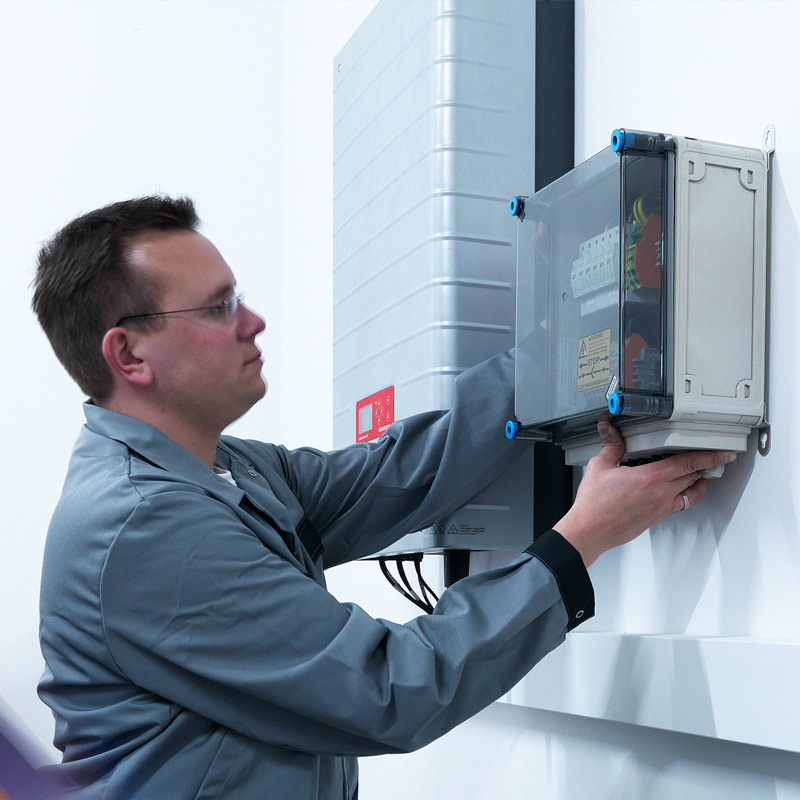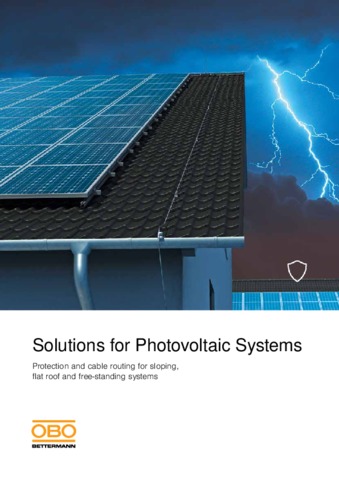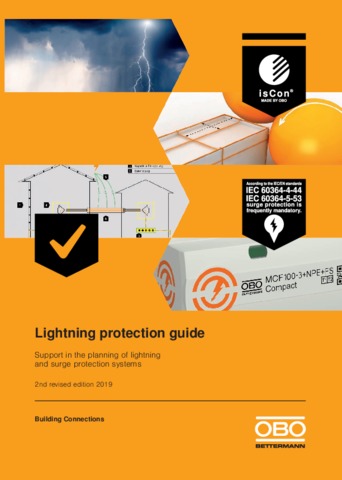Surge protection for photovoltaic systems
There are always two sides to the surge protection of PV systems. Both on the direct current side (DC) and on the alternating current side (AC), surge voltages can be coupled into the system. The consequence can be damage to the inverters. OBO surge protection reliably and comprehensively protects every side. Existing data cables can be safely included in the equipotential bonding using suitable protection devices.
Surge protection on systems without external lightning protection
On systems without an external lightning protection system, standards do not require surge protection on the DC side. Nonetheless, its use is expressly recommended, so that the photovoltaic system is protected when surge voltages occur, for example due to switching actions in the network. At the same time, this protects the availability of the system.
To offer the inverter the best possible protection against dangerous surge voltages, surge protective devices should be used directly at the inputs and at the output on both the direct and alternating current sides.
When selecting a surge protective device for the direct current side of the photovoltaic system, the highest open circuit voltage of the PV system may, under no circumstances, exceed the highest continuous voltage of the surge protection device. The number of required protective devices is calculated from the number of MPP trackers in the appropriate PV system.
If the inverter is connected to information or communication equipment, then these cables should also be included in the equipotential bonding using suitable surge protective devices.

Surge protection systems for PV systems
A product range for any application:
- Lightning arrester/combination arrester
- Surge protection for energy and data technology
- Complete system solutions, terminated and pre-mounted in the housing
- Combination and surge arrester for photovoltaics, DC side
- Relevant directives
The following directives are to be taken into account for standardised surge protection of photovoltaic systems:
- To prevent surge damage, a lightning protection system according to VDE 0185- 305-3 (IEC/ EN 62305-3) is recommended for PV on-roof systems.
- A risk analysis according to VDE 0185-305-2 helps to determine the necessity of a lightning protection system, as well as the required lightning protection class. This only applies for cases in which additional directives, such as the state construction regulations, do not require any other lightning protection systems.
For complex PV outdoor systems, such as PV power stations or solar parks with the requirement for increased availability, it is wise to check the necessity or requirement for additional measures, taking VDE 0185-305-2 into account. - Only a protected system can withstand the loads to which it is exposed and safely produce energy over a long period of time. This is why property insurance companies continue to recommend internal surge protection for outdoor PV systems in the new edition of the VdS directive 2010 (February 2021).
- The standards of the VDE 0100 series, particularly DIN VDE 0100-712, apply to the erection of PV power supply systems.
- If a PV system is newly installed and connected to the electrical system, then surge protection (type 2/class II) is to be added on the AC side, in accordance with DIN VDE 0100-443 and DIN VDE 0100-712 (IEC 60364-4-44 and 60364-7-712).
- The additional reference to VDE 0185-305-3, Supplementary Sheet 5, in DIN VDE 0100-712 means that, besides the AC side, the DC side also has a requirement for a surge protection system, in order to contribute to the safety of the inverter on systems with an external lightning protection system.
- Surge protective devices: Selection and required quantity
The following points should be particularly observed during the selection:
- The highest continuous voltage of a surge protective device for the direct current side of the photovoltaic system may, under no circumstances, exceed the highest idling voltage of the PV system.
- The number of required protective devices is calculated from the number of MPP trackers in the appropriate PV system.
- If the inverter is connected to information or communication equipment, then these cables should also be included in the equipotential bonding using suitable surge protective devices.
With PV systems on buildings, the installation of the inverter may be carried out directly on the roof, in the attic or, ever more frequently, in the basement, depending on the local circumstances. In the case of installations in the basement, it can be wise to place the surge protection not only in front of the inverter, but also at the entry of the cables into the building, in order to avoid inductive couplings from outside.
- OBO solutions for a safe photovoltaic system
Surge protection for PV systems always has two sides: Both on the direct current side and on the alternating current side, surge voltages can be coupled into the system for all kinds of reasons and, for example, damage the inverter. OBO surge protection reliably protects every side. To protect the DC-side input of the inverter, OBO offers a portfolio of generator connection boxes with lightning and surge protection.





